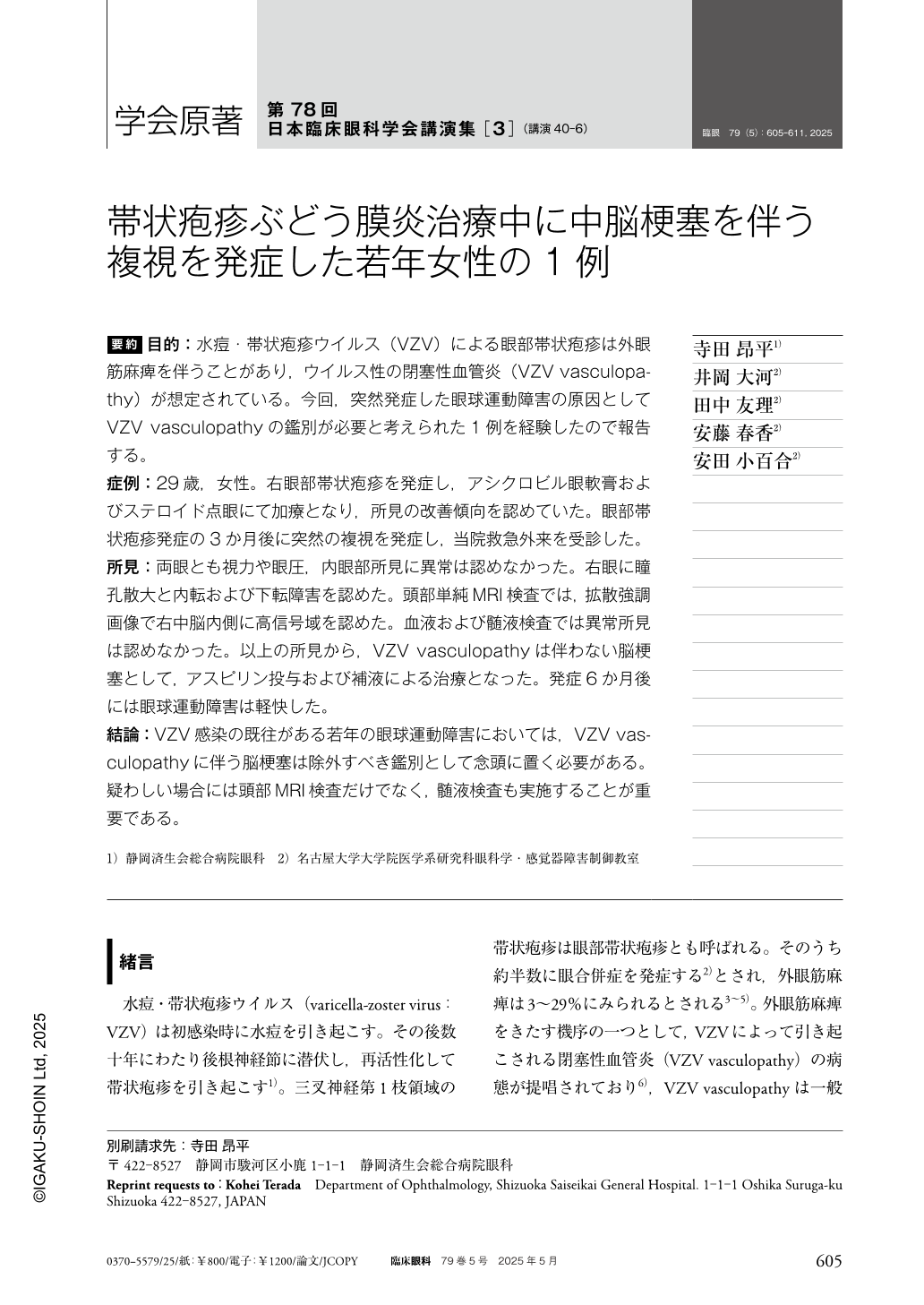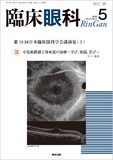Japanese
English
- 有料閲覧
- Abstract 文献概要
- 1ページ目 Look Inside
- 参考文献 Reference
要約 目的:水痘・帯状疱疹ウイルス(VZV)による眼部帯状疱疹は外眼筋麻痺を伴うことがあり,ウイルス性の閉塞性血管炎(VZV vasculopathy)が想定されている。今回,突然発症した眼球運動障害の原因としてVZV vasculopathyの鑑別が必要と考えられた1例を経験したので報告する。
症例:29歳,女性。右眼部帯状疱疹を発症し,アシクロビル眼軟膏およびステロイド点眼にて加療となり,所見の改善傾向を認めていた。眼部帯状疱疹発症の3か月後に突然の複視を発症し,当院救急外来を受診した。
所見:両眼とも視力や眼圧,内眼部所見に異常は認めなかった。右眼に瞳孔散大と内転および下転障害を認めた。頭部単純MRI検査では,拡散強調画像で右中脳内側に高信号域を認めた。血液および髄液検査では異常所見は認めなかった。以上の所見から,VZV vasculopathyは伴わない脳梗塞として,アスピリン投与および補液による治療となった。発症6か月後には眼球運動障害は軽快した。
結論:VZV感染の既往がある若年の眼球運動障害においては,VZV vasculopathyに伴う脳梗塞は除外すべき鑑別として念頭に置く必要がある。疑わしい場合には頭部MRI検査だけでなく,髄液検査も実施することが重要である。
Abstract Purpose:Varicella-zoster virus(VZV)causes chickenpox upon initial infection and reactivates to cause herpes zoster. Ocular shingles may be accompanied by paralysis of the external ocular muscles, and VZV vasculopathy is postulated to be one of the mechanisms of this paralysis. We report a case of VZV vasculopathy as a cause of sudden onset of ocular motility disorder.
Case:A 29-year-old woman with systemic lupus erythematosus. She was taking medication for systemic lupus erythematosus and the symptoms were well controlled. She developed uveitis associated with VZV on the right side of the face and was treated with acyclovir ophthalmic ointment and steroid eye drops, and her findings improved. Three months after the onset of uveitis, she suddenly developed diplopia and presented to our emergency department.
Findings:There were no abnormalities in the internal ocular findings including visual acuity, intraocular pressure, or fundus findings in either eye. Pupillary dilatation, adduction and retraction deficits were observed in the right eye. A magnetic resonance imaging(MRI)scan of the head showed a high-intensity area medial to the right midbrain on diffusion-weighted images. Blood tests showed no abnormality in the blood coagulation system, and cerebrospinal fluid tests showed no increase in the number of protein cells. Based on these findings, she was treated with Bayaspirin and supplemental fluids as if it were a cerebral infarction without VZV vasculopathy. One month after onset, her diplopia showed signs of improvement, and six months after onset, the ocular motility disorder had lessened.
Conclusions:In young patients with ocular motility disorder with a history of VZV infection, cerebral infarction should be considered as a differential diagnosis, and in particular, cerebral infarction associated with VZV vasculopathy should be kept in mind as a differential diagnosis to exclude. If there is any doubt, it is important to perform not only a head MRI but also a cerebrospinal fluid examination.

Copyright © 2025, Igaku-Shoin Ltd. All rights reserved.


